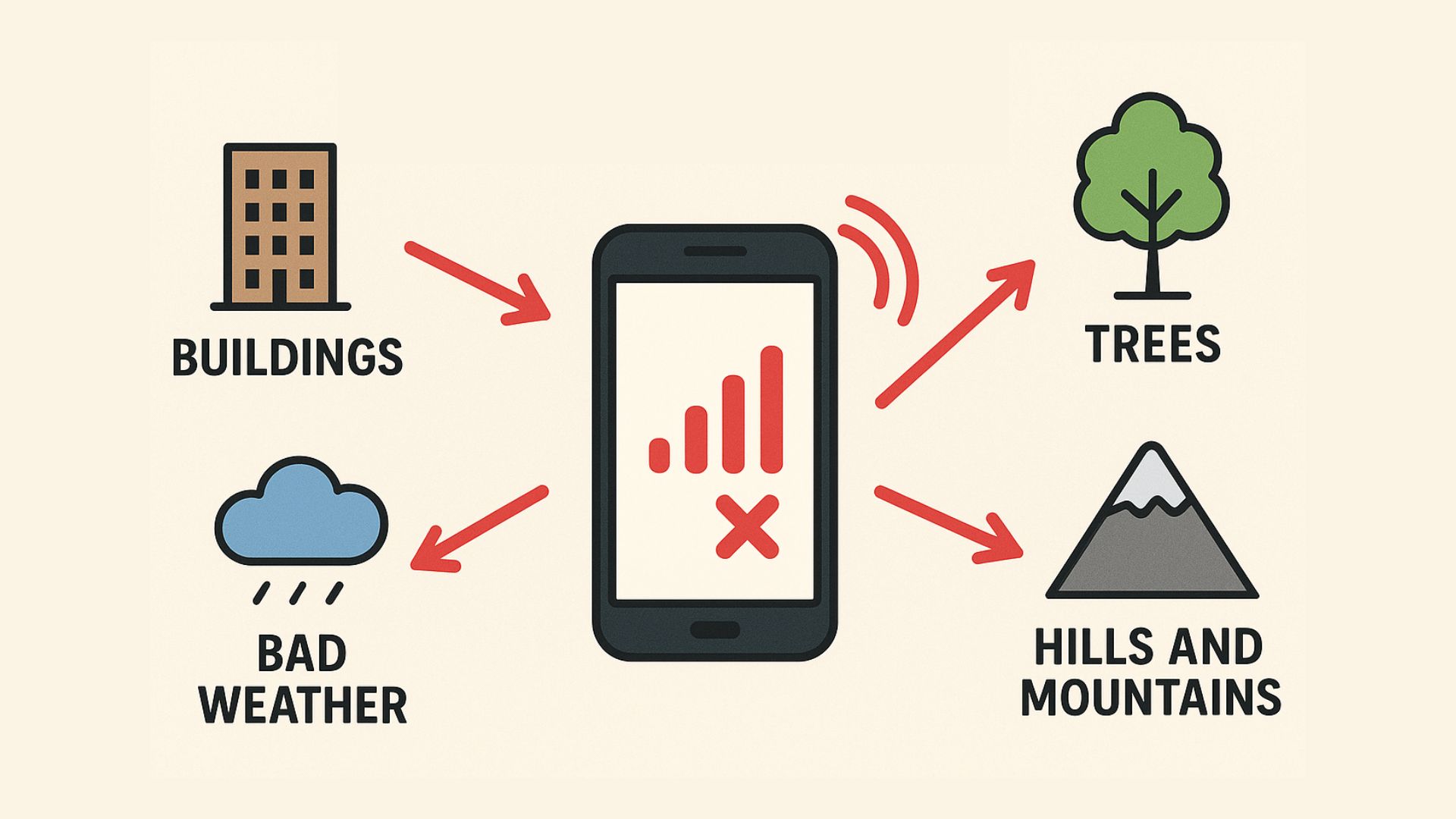What Causes Poor Mobile Phone Signal? (And How to Fix It)

Mobile networks have improved a lot over the past decade or so, with faster speeds and wider coverage than ever before, but it’s still possible to find spots with weak signal – including in towns and cities. If this sounds familiar to you, then you’ll know all too well how frustrating the problem can be. But what exactly causes it?
Poor mobile signal can be caused by a number of different factors, including:
- Distance (from a cell tower)
- Physical obstructions (including buildings)
- Adverse weather conditions
- Network congestion
- Carrier issues
That said, if you find yourself in an area with poor mobile connectivity, there are still a few things you can do to boost your chances of getting back on the grid. Read on to find out more.
Network Coverage Gaps
A mobile network (or a “cellular” network) works by dividing a large area into cells, each of which is served by a base tower that facilitates communication with the wider network. Devices communicate with base towers through radio waves – some of which you might recognise as 3G, 4G and 5G.
When your phone is in a cell with good coverage, that means it can send and receive data quickly from a base tower – often because it’s close by or there are no obstacles in the way. However, if you move outside the optimal range of a tower, your phone may experience a weaker signal. This is often the case in rural areas, where network providers haven’t yet invested in infrastructure upgrades.
If you experience a persistent weak signal, a network coverage gap could be the cause. Ofcom’s mobile coverage map can help you confirm whether or not this is the case – it provides a breakdown of signal strength across all major carriers, including EE, O2, Three and Vodafone.
In terms of fixes, there are a few solutions available to you:
- Wi-Fi Calling – If your carrier supports Wi-Fi calling, you can make calls and send texts over your broadband connection instead.
- Switch Providers – It might be the case that another carrier offers a better signal in your area, in which case you might want to change.
- Mobile Signal Booster – If neither of these options are available to you, a mobile signal booster could be the best option.
Read our full guide on mobile phone signal boosters to learn whether they’re the right solution for your home or business.
Physical Obstructions
Even though towns and cities have a higher density of cell towers, you may still encounter areas of weak mobile signal – especially indoors. That’s because modern building materials, like steel and concrete, act as a dampener, absorbing and sometimes blocking the radio waves that carry a cellular signal. What’s more, higher frequencies, like 5G, struggle to penetrate buildings, which can worsen problems relating to poor indoor reception.
Read our blog, How Building Materials Affect Mobile Phone Signal, to find out more.
If you work in a modern office building and you experience dropped calls and slow internet speeds routinely, then many of the solutions outlined in the previous section apply. Due to the effect a poor signal can have on your business – from disrupted communication to slower workflows – it might be worth investing in an Ofcom-approved signal booster. These work by capturing a weak signal and amplifying it indoors, covering multiple floors and large office spaces in the process.
Learn more about tailored solutions and how NetCov can help enhance your office’s mobile signal with a professional-grade installation. Explore our Mobile Signal Boosters for Offices.

Environmental Factors
Mobile networks rely on radio frequency signals to send and receive data, which means they can be influenced by atmospheric conditions, including bad weather. Rain, fog, and snow can all weaken mobile signal — and if your connection is already poor, the UK’s frequent bad weather can make the problem even worse.
Weather can affect your signal either directly or indirectly. Direct interference is when weather conditions affect the path of radio waves – for instance, when rain causes them to scatter as they pass through water droplets. Signals in higher frequency bands (e.g., 5G) can be more susceptible, as shorter wavelengths are disrupted more easily.
Indirect interference, though rarer, can still be a problem – especially in hard-to-reach areas. Storm damage to network infrastructure can quickly turn a weak signal into no signal at all. And with extreme weather conditions set to become more regular over the coming years, it’s likely that network resilience will continue to be challenged.
Worried about the effect the UK’s unpredictable weather could have on your home or business? Learn how our Ofcom-approved signal boosters can keep you connected.
Network Congestion
Even with sunny skies and strong network coverage, your mobile signal can still be negatively impacted when too many devices are trying to connect to the same cell tower at once. This is known as network congestion, and if you’ve ever been to a music festival or a sporting event, you’ve probably experienced it at some point.
Just like any other piece of infrastructure, a cell tower can only handle so many connections at once. And when demand exceeds that capacity, signal quality drops. That’s because every tower uses only a finite portion of the radio spectrum – its available bandwidth. When you send and receive data over a mobile connection, your device is assigned a slice of the available frequency for as long as it needs. The problem arises because a tower’s bandwidth can only be divided in so many ways. Once it’s exhausted, there’s nothing left for new connections.
Solutions for end users include switching to a different network band (e.g. from 4G to 3G) if one is overloaded or routing calls and texts through a WiFi connection. In terms of infrastructure, a signal booster can help users make better use of whatever capacity is available.
Carrier Issues
Sometimes a poor connection has nothing to do with your phone, the weather conditions or congestion – it might be down to your carrier. Occasionally, carriers experience outages due to maintenance, software failures or technical problems, leaving end-users without a reliable connection. In a recent case, EE experienced an outage during which thousands of its customers were unable to make calls or receive messages.
In the event of an outage, the first step is to confirm the problem. Checking your carrier’s website, app, or social media channels should confirm whether there’s a known issue. If nothing is reported, the issue may be localised, in which case, restarting your phone or checking your SIM can help to diagnose any problems.
Should you experience persistent issues, it might be worth changing your carrier. Again, Ofcom’s mobile coverage map will let you know which network offers the best connection in your area. If changing your carrier isn’t an option, then a signal booster could bring you a reliable connection – even in rural areas with weak coverage. Read our blog, ‘How Can I Boost My Mobile Signal in Rural Areas?’ for more insights.
Final Thoughts: Fixing Poor Mobile Signal
From weather and building materials to network congestion, coverage gaps or even your carrier itself, poor mobile signal is rarely caused by one issue alone. In fact, there are multiple factors that can combine to interfere with an otherwise reliable connection. The good news is that, whatever the cause, there’s always a solution.
If persistent problems with poor mobile signal are holding you back, then NetCov can help. Explore our tailored solutions and find out more about how we can keep you connected, wherever you are. For more information, get in touch with one of our team members today and source your ideal solution.
